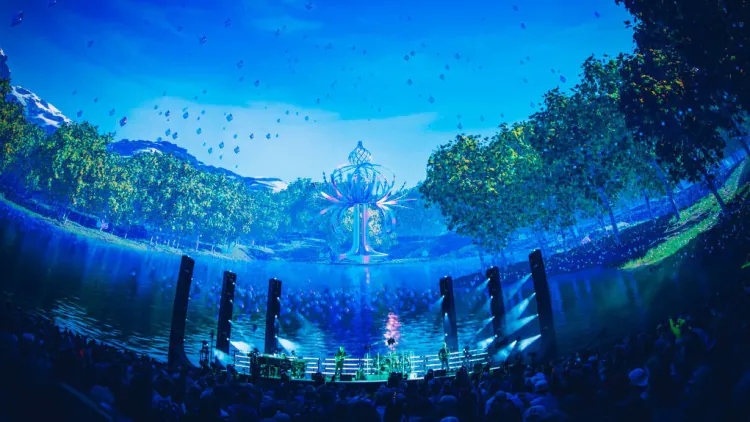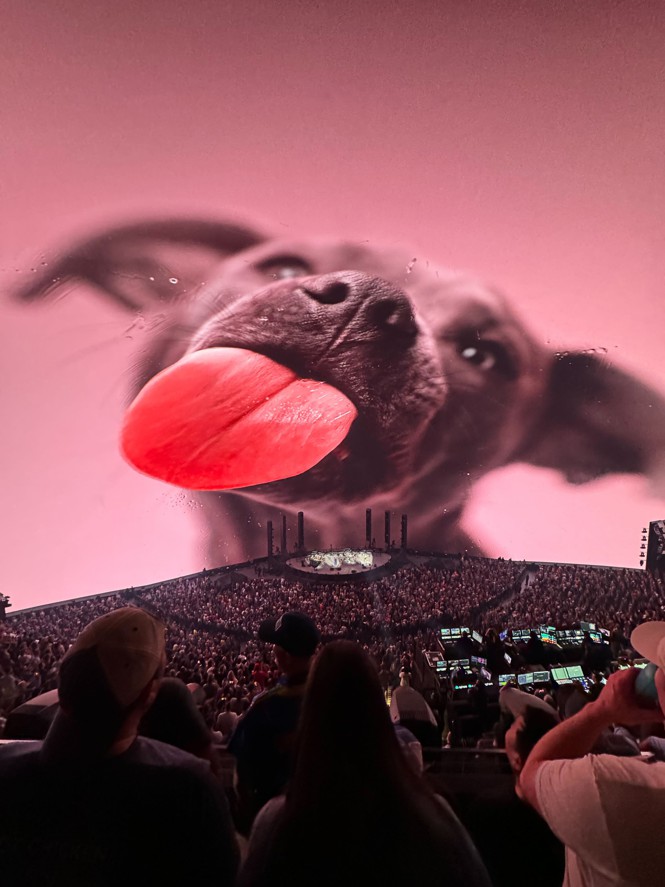Sphere Is the Mind-Killer
What it’s like to groove on Earth’s only LED moon

In Las Vegas last Friday, I watched a Godzilla-sized puppy give a tongue bath to some 18,000 people. The visual—accompanied by laughter, slack jaws, and modest plumes of vaporized weed—arrived roughly three hours into a performance by Phish, the storied band, which has now been around for 40 years. At the moment in question, the band was launching into a capella scatting and mouth noising—what fans recognize as a vocal jam. And of course we were at the Sphere, a glorious, $2.3 billion arena that asks and answers the questions: What if the Earth had a moon that was made entirely of screens? And what if we took a spaceship there and grooved on it?
There is a lot to say about the visuals projected onto the walls of this place and its seeming bioluminescence. But trying to describe what happens inside the Sphere when the lights go down has a lot in common with recounting a dream or the play-by-play of a psychedelic experience: It easily veers toward the self-indulgent, tedious, and cliché. How did it feel, man? Honestly, it was tight. Like, really tight. I scrawled some phrases in my notepad as the show was under way:
Like being inside a planetarium while it’s burning
Audience attacked by jazz UFOs
Floating, non-playable Sims characters flopping around the ocean floor
But that’s the obvious stuff. Although Phish was doing a commendable job dazzling our rods and cones with a 366-foot spectacle that the Sphere alone can deliver, they had cracked the code on something much more important: the venue’s sound system, which is equipped with wave-field-synthesis spatial-audio technology. (That’s a fancy way of saying that individual sounds can be projected to pinpointed locations in the room, from any direction.) Night one was a touch sonically disorienting. But by night two, the foursome was in sync with the building itself, energetically bobbing and weaving through orchestrated set pieces and diffuse, bowel-shaking improvisations. (Perhaps my brain’s temporal lobe just needed to acclimate.)
[Read: Sphere and loathing in Las Vegas]
Phish, led by the frontman and guitarist Trey Anastasio, squeezed every drop out of this technology, which meant using the venue’s 1,586 fixed loudspeakers to bounce audio all around the room. What might feel like a gimmick in the hands of most acts hits different for Phish, whose music, as the critic Amanda Petrusich once aptly noted, unfurls “like a drop of food coloring squeezed into a bowl of water.” Anastasio’s lilting arpeggios wound around my head in Section 204 before skittering off toward the rounded heavens of the 400-level; an errant cymbal from the drummer, Jon Fishman, splashed at my left ear and disappeared, replaced by a rich grand-piano chord until, seconds later, a ride cymbal careened into my right ear as the jam reached a crescendo. It was sensory overload—but a good kind. The band, their production-design crew, and the Sphere itself had created a very specific recreational experience, like one of those immersive NASA flight-simulation modules; instead of flying a rocketship, it simulated doing just the right amount of psychoactive drugs during a concert.
Phish’s second night was my third experience inside the Sphere—which is arguably more Sphere consumption in a 12-month period than would be recommended for one’s limbic system. My first excursion, to see U2, stemmed from a deep, almost primal impulse to wash my eyeballs in 16K resolution. I wondered what the Sphere might tell us about screens—not just the 360-foot ones, but also the ones we keep in our pockets. U2 was, to a degree, ancillary to the experience: I wanted LED oblivion, and I got it. This accomplished, I expected never to return. What more could the Sphere offer me?
But I am weak. My Cro-Magnon brain thirsted for another pixel-induced dopamine hit. Plus, maybe I missed something. The Sphere positions itself as the “future of immersive entertainment”; perhaps there will one day be many Spheres dotting the globe. (A Madison Sphere Garden for New York?) Is this place an expensive laboratory to turn middle-aged Phishheads with substantial disposable income into crash-test dummies for this future? Is it just a residency for bands to relive the glory days? What is the Sphere for?
Phish’s four-night run offered hints. During “Wading in the Velvet Sea,” a slow, emotional ballad that kicked off the second night’s encore, the Sphere cycled through and then filled with photos of the band throughout its 40 years—in college; then awkwardly cradling their newborn children, playing to sold-out crowds, goofing off backstage, looking impossibly young; and then, just a touch more like a college-faculty jazz band. Dads who shred. Online, an observer quipped that it was Phish’s “Eras Tour” moment, a reference to Taylor Swift’s pop-culture mega-event. The band played a stacked set list each night, all but guaranteeing that those who came for the entire run would hear most of the band’s most famous songs live. But their stay was limited, ensuring that Phish’s Sphere term couldn’t be categorized as a last waltz, self-elegy, or living-museum situation.
The band appeared to treat it as the opposite: a new artistic frontier. The show’s director, Abigail Rosen Holmes, had worked with the longtime lighting director Chris Kuroda to build out a series of set pieces for the band that would work alongside Phish’s usual process of written songs that evolve into twisty, surprising improvisations. Unlike U2, who played a similar list of songs each night, set to the same visualizations, Phish’s challenge was essentially to get the $2 billion architectural marvel to jam in sync with the band. In interviews, Anastasio described a painstaking process of planning and rehearsal, layering in Easter eggs and brain-melting visuals that might be enough to make a Phish diehard experiencing their 300th show feel like they’re seeing something new.
Judging by the exclamations from two exultant, gyrating 20-somethings in the row in front of me on the first night, I’d argue the band succeeded. After assuring me that he was, in fact, not “tripping balls,” one of the men, who’d spent most of the second set alternating between staring agog at the building’s roof and yelling “YESSSSSSS” to nobody in particular, exclaimed, “This was like the first time again.”
On night two, I sat in the 300-level, just above Rosen Holmes, Kuroda, and the dozen or so humans staffing various screens and soundboards. Their setup looked like a small mission-control hub preparing to launch a rocket, which, in a manner of speaking, it was. I watched the crew’s shadows from behind all night as they twirled knobs, tweaked sliders, and punched screens, bending this ridiculous building to the whims of the band onstage playing songs, some of which were written in a Vermont dorm room 40 years ago. At the end of the evening, during Anastasio’s dazzlingly complex and orchestrated “You Enjoy Myself,” the notes stopped and the house lights rose. This was the moment when time stood still and a massive dog appeared before us, closed its eyes, and pressed its tongue against the Sphere for a taste of its glorious pixels.
I’m not sure it was meant to be the evening’s revelatory moment, but I found it as such. I don’t know whether the Sphere is the future of live music—it’s very expensive, both to build and attend, and the venue’s path to profitability isn’t clear at all. But I do know this: The Sphere is a mountain, a rentable peak that a rarefied stable of performers can gain access to when they’ve climbed all the others available to them.
That’s a subjective descriptor, of course. A Grammy could be a mountain; so could a run at a venue like Madison Square Garden or Red Rocks, a sold-out tour, a Super Bowl halftime show, or a concept album. Some mountains are bigger than others. A musician friend of mine recently described Taylor Swift’s dominating success as akin to beating a game so thoroughly that she needed to go out and invent her own (thus the Eras Tour).
[Read: Beyoncé stands her ground]
The Sphere, more than anything else, is a challenge for a specific kind of artist. “I mean, I can’t imagine what Beyoncé could do in a place like this,” Anastasio told CBS News last week. “She should come.” There’s so little overlap between Phish and Beyoncé—musically, stylistically, culturally—that seeing the two in the same sentence is a bit jarring. But both acts do seem to share a similar, relentless creative work ethic. Their mountains may look different, but the performers have things in common: an intense attention to detail and craft, an innate drive to scale and push their art ever upward. (See Beyoncé’s genius, radical 2018 Coachella performance, for example.)
Eventually, every artist runs out of mountains to climb, or—at the very least—needs a little help finding the high-test 92-octane fuel that can successfully power the creative engine that idles in their brain. Enter the Sphere: a mountain with no sharp edges. A garish, glowing Mount Everest in the middle of the desert.
What's Your Reaction?




















